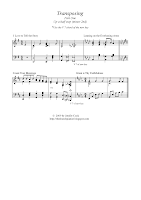Before a pianist can improvise effectively,
one must have a common knowledge of the
major and minor scales.
Of course some pianists play by ear and may
sound wonderful but cannot explain theoretically
what they're doing.
I know...I also can play by ear but read music and
have studied theory. I do not claim to be the theory
expert but did have teachers that required me to
learn theory.
Over the past ten years, I've learned a good bit of
theory through personal study.
It's imperative to have a working knowledge of the
scales and chords in all major and minor keys.
Today's image displays some very important tools
that prepare the church pianist for improvising.
It's really quite simple when learning the scales and
chords with the numbering system.
For example, a scale consists of 8 notes. A chord can
be built on each note of the scale as demonstrated in
today's image.
When numbering the chords in the scale...the upper
case roman numeral refers to a Major chord and the
lower case roman numeral indicates a minor chord.
Notice, the notes in the chords are made up of 3rds.
Meaning....the notes are a third apart from each other.
Anytime a three note chord consists of consecutive
thirds...it is in root position...meaning...the bottom
note of that chord names the chord.
For example...the chord (CEG) is called a C chord
because it's made of consecutive 3rds and the
bottom note is 'C'.
Now you're ready to hear about chord extensions.
To create a richer or fuller chord...add another note
a 3rd from the top note. This is called extending
the chord.
For example: The C chord (CEG).
Add another note a 3rd from the top and you now
have: CEGB
Chord extensions can be used for either hand.
They work best in the left hand.
The scales and chords are the foundational tools
for learning to improvise.
For starters, learn the scales for the easy major
keys with their chords (triads).
Try: C, G, D and F Major
My new website: http://thechurchpianist.com/




